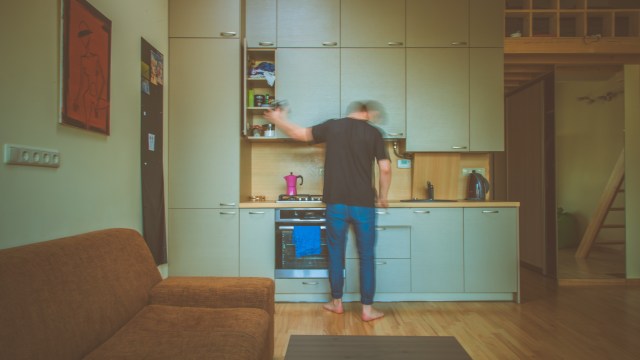6 simple ways to get the most out of your workout

Photo credit: Victor Freitas on Unsplash
- Not everyone wants the same thing out of a workout session. We each have our distinct goals.
- We should keep in mind that pain doesn’t always mean gain.
- You are much more likely to succeed in your exercise goals if you hold yourself accountable by writing down your intentions and plans.
Whether you’re a person who can’t wait for their next trip to the gym or 5K run, or someone who is still working to make working out a priority, we all want to make sure that every minute we spend exercising counts.
It’s also important to recognize that not everyone wants the same thing out of a workout session. While some are looking to improve their health, others may want to build their strength or endurance to get better at a sport, while others turn to exercise or other gentler forms of movement (like yoga or tai chi) for stress relief.
We should also remember that pain is not always gain. “Yes there may be some level of difficulty as you build up your stamina and strength, but pain is never a good thing, and you can get fit without pushing yourself to the point of hurting,” Bert Mandelbaum, M.D., a sports medicine specialist and co-chair of medical affairs at Cedars-Sinai Kerlan-Jobe Institute in Los Angeles and author of The Win Within: Capturing Your Victorious Spirit, tells Thrive Global.
It’s up to you to determine your priority, but regardless of what it is, you should be getting the most out of your workout. Here are some tips from experts on how to do exactly that:
Have a consistent workout plan…
One way to maximize the benefits of your workout is to stick to a consistent plan. Rather than cramming a week’s worth of exercising into the weekend, Mandelbaum recommends trying to regularly schedule 30 minutes of movement each day. The half-hour doesn’t even need to be all at the same time: you can try breaking it up into two 15-minute segments, he says. And yes, out-of-the-gym activities like walking the dog, raking leaves, or taking the stairs instead of the elevator all count as exercise.
… But vary the exercises
So yes, you’re going to want to stick with a consistent workout schedule, but it’s a good idea to change up the exercises you’re doing, Mandelbaum explains. Not only does this keep things more interesting, but repetitive motion over time can really wear down and stress the muscles and joints, and make them more prone to injury, he says. To avoid this, instead of doing the same exercise three or four days in a row, Mandelbaum suggests switching it up and alternating with something different for one or two of the days to engage different sets of muscles.
Try an exercise ball
Chances are you already have one of those big exercise balls (also called Swiss balls) in a closet at home or sitting somewhere in your office — now is the time to put it to use. For starters, it’s a great addition to your regular workout, allowing you to stretch and move your spine in a controlled manner, Neel Anand, M.D., professor of orthopaedic surgery and director of spine trauma at Cedars-Sinai Spine Center in Los Angeles, tells Thrive. You can use the exercise ball for everything from crunches, squats, planking, and other forms of stretching, according to the Mayo Clinic (here’s some inspiration and visuals to get you started).
“Moving the vertebrae in this way can help nourish discs in the spine by increasing blood flow and lubrication to them,” she says. “Additionally, using an exercise ball in conjunction with core strengthening exercises will work the abdominal muscles and help to stabilize the spine.” They are also great for “active sitting,” engaging muscles while you’re working at a desk or watching TV.
Don’t forget about recovery
Your exercise session isn’t over when you step off the treadmill — cooling down and having a recovery period is also an important part of maximizing your workout. Stretching after a cooldown will loosen any tight muscles and increase flexibility, which will help for the next workout, Mandelbaum explains. You may also want to try using a foam roller after exercising, John Soberal, DPT, a doctor of physical therapy at Providence Saint John’s Health Center’s Performance Therapy in Santa Monica, CA, tells Thrive. He explains that it may help to “iron out” fascia — the connective tissue that envelops muscles that tend to cause mobility restrictions.
Plan meals around your workout
We’re not suggesting reorganizing your whole life around going to the gym, but some thoughtful meal planning can help ensure your workout is as effective as possible. For example, if you plan to exercise in the morning, don’t eat dinner too close to when you’re going to bed, Hannah Dove, DPT, a doctor of physical therapy at Providence Saint John’s Health Center’s Performance Therapy in Santa Monica, CA, tells Thrive. “Eating an extremely late dinner will make it harder for your body to digest on time and then you might feel sluggish when you wake up in the morning,” she says.
But, do take the time to prepare or set out your breakfast for the next morning, Dove recommends. That way you won’t waste time or energy deciding what to make. Then, the next morning, wake up and eat a light breakfast — like a banana and some peanut butter, or a hard-boiled egg and toast — to help give your body good fuel to use during the workout. “In order to perform well, your body needs the right fuel at the right times, so make it easier on your body instead of working against it,” she adds.
Use your unplugged time to plan your workout
We’re big proponents of unplugging from devices to ease your body into sleep mode— ideally at least 30 minutes before bed. Dove suggests extending that to one or two hours, if possible, and using that time without electronics to plan your workout for the next day. “Picking what exercises and the order the night before will take all the guesswork and stress out of it the next day,” she notes. “Set your plan the night before, and then all you have to worry about the next day is executing your plan.” Your plan doesn’t have to be complicated: it can be as simple as queueing up your favorite exercise video or audio workout, deciding whether to take a class at the gym or go straight to the elliptical, or taking the time to visualize yourself going through the moves and getting in a great, productive workout.
And while you’re unplugged from your devices in the evening, Dove also recommends taking the time to write out your goals for the following day. These can be specific to your workout, or general health and fitness goals with ideas of how you plan on achieving them. “You are much more likely to succeed if you hold yourself accountable by writing down your intentions and plans,” she explains.
Reprinted with permission of Thrive Global. Read the original article.





